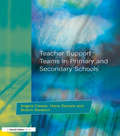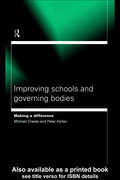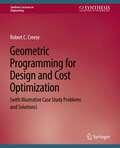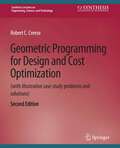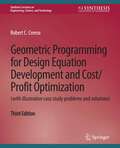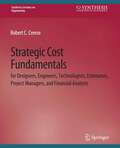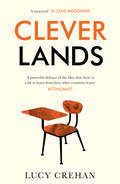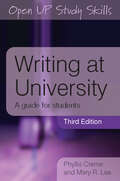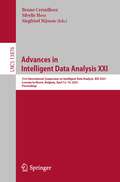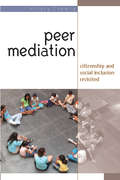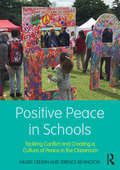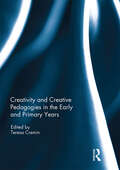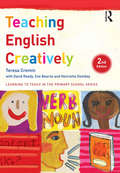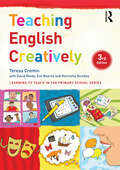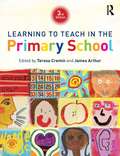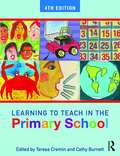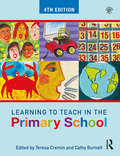- Table View
- List View
Teacher Support Teams in Primary and Secondary Schools
by Angela Creese Brahm Norwich Harry DanielsFirst Published in 1997. Routledge is an imprint of Taylor & Francis, an informa company.
Improving Schools and Governing Bodies: Making a Difference
by Michael Creese Peter EarleyThis book provides school governors with a blueprint for working effectively and enthusiastically to bring about positive change in their schools, for the benefit of all those concerned.
Improving Schools and Governing Bodies: Making a Difference
by Michael Creese Peter EarleyThis book provides school governors with a blueprint for working effectively and enthusiastically to bring about positive change in their schools, for the benefit of all those concerned.
Geometric Programming for Design and Cost Optimization (Synthesis Lectures on Engineering, Science, and Technology)
by Robert CreeseGeometric programming is used for design and cost optimization and the development of generalized design relationships and cost rations for specific problems. The early pioneers of the process, Zener, Duffin, Peterson, Beightler, and Wilde, played important roles in the development of geometric programming. The theory of geometric programming is presented and 10 examples are presented and solved in detail. The examples illustrate some of the difficulties encountered in typical problems and techniques for overcoming these difficulties. The primal-dual relationships are used to illustrate how to determine the primal variables from the dual solution. These primal-dual relationships can be used to determine additional dual equations when the degrees of difficulty are positive. The goal of this work is to have readers develop more case studies to further the application of this exciting mathematical tool. Table of Contents: Introduction / Brief History of Geometric Programming / Theoretical Considerations / Trash Can Case Study / Open Cargo Shipping Box Case Study / Metal Casting Cylindrical Riser Case Study / Process Furnace Design Case Study / Gas Transmission Pipeline Case Study / Journal Bearing Design Case Study / Metal Casting Hemispherical Top Cylindrical Side Riser / Liquefied Petroleum Gas(LPG) Cylinders Case Study / Material Removal/Metal Cutting Economics Case Study / Summary and Future Directions
Geometric Programming for Design and Cost Optimization 2nd edition (Synthesis Lectures on Engineering)
by Robert CreeseGeometric programming is used for design and cost optimization, the development of generalized design relationships, cost ratios for specific problems, and profit maximization. The early pioneers of the process - Zener, Duffin, Peterson, Beightler, Wilde, and Phillips -- played important roles in the development of geometric programming. There are three major areas: 1) Introduction, History, and Theoretical Fundamentals, 2) Applications with Zero Degrees of Difficulty, and 3) Applications with Positive Degrees of Difficulty. The primal-dual relationships are used to illustrate how to determine the primal variables from the dual solution and how to determine additional dual equations when the degrees of difficulty are positive. A new technique for determining additional equations for the dual, Dimensional Analysis, is demonstrated. The various solution techniques of the constrained derivative approach, the condensation of terms, and dimensional analysis are illustrated with example problems. The goal of this work is to have readers develop more case studies to further the application of this exciting tool. Table of Contents: Introduction / Brief History of Geometric Programming / Theoretical Considerations / The Optimal Box Design Case Study / Trash Can Case Study / The Open Cargo Shipping Box Case Study / Metal Casting Cylindrical Riser Case Study / Inventory Model Case Study / Process Furnace Design Case Study / Gas Transmission Pipeline Case Study / Profit Maximization Case Study / Material Removal/Metal Cutting Economics Case Study / Journal Bearing Design Case Study / Metal Casting Hemispherical Top Cylindrical Side Riser\\Case Study / Liquefied Petroleum Gas (LPG) Cylinders Case Study / Material Removal/Metal Cutting Economics with Two Constraints / The Open Cargo Shipping Box with Skids / Profit Maximization Considering Decreasing Cost Functions of Inventory Policy / Summary and Future Directions / Thesis and Dissertations on Geometric Programming
Geometric Programming for Design Equation Development and Cost/Profit Optimization (Synthesis Lectures on Engineering)
by Robert CreeseGeometric Programming is used for cost minimization, profit maximization, obtaining cost ratios, and the development of generalized design equations for the primal variables. The early pioneers of geometric programming—Zener, Duffin, Peterson, Beightler, Wilde, and Phillips—played important roles in its development. Five new case studies have been added to the third edition. There are five major sections: (1) Introduction, History and Theoretical Fundamentals; (2) Cost Minimization Applications with Zero Degrees of Difficulty; (3) Profit Maximization Applications with Zero Degrees of Difficulty; (4) Applications with Positive Degrees of Difficulty; and (5) Summary, Future Directions, and Geometric Programming Theses & Dissertations Titles. The various solution techniques presented are the constrained derivative approach, condensation of terms approach, dimensional analysis approach, and transformed dual approach. A primary goal of this work is to have readers develop more case studies and new solution techniques to further the application of geometric programming.
Strategic Cost Fundamentals: for Designers, Engineers, Technologists, Estimators, Project Managers, and Financial Analysts (Synthesis Lectures on Engineering)
by Robert CreeseThis book is designed to introduce designers, engineers, technologists, estimators, project managers, and financial analysts as well as students in engineering and business to strategic cost tools for project cost evaluations. The three main sections are as follows. (1) Cost Relationships, Financial Statements, and Performance Measures—This section describes the relationships between cash flows and profits; the relationships between financial statements and the Purcell Diagram; and the issues of cost estimating, time-based breakeven analysis and time-based earned schedule. (2) Tools for Economic Evaluations—This section considers the basic mathematical relations used behind the economic equations and factors; discrete and continuous interest; depreciation terms and methods; and the Present Value of Principal Approach for evaluating loans. (3) Methods for Project Evaluation and Risk Analysis—This section considers payback periods, present worth analysis, return on investment, internal rate of return, benefit/cost ratios and positive-negative project balances; risk techniques of sensitivity analysis, optimistic-pessimistic analysis, discrete probability examples, and continuous probability models using the normal and triangular distributions.
Cleverlands: The Secrets Behind the Success of the World’s Education Superpowers
by Lucy CrehanAs a teacher in an inner-city school, Lucy Crehan was exasperated with ever-changing government policy claiming to be based on lessons from ‘top-performing’ education systems. She resolved to find out what was really going on in the classrooms of countries whose teenagers ranked top in the world in reading, maths and science. Cleverlands documents Crehan’s journey around the world, weaving together her experiences with research on policy, history, psychology and culture to offer extensive new insights into what we can learn from these countries.
EBOOK: A Guide For Students (UK Higher Education OUP Humanities & Social Sciences Study Skills)
by Phyllis Creme Mary LeaWriting at University offers guidance on how to develop the writing you have to do at university along with a greater understanding of what is involved in this complex activity. Writing is seen as a tool for learning as well as a product to be assessed. The importance of what you yourself can bring as a writer to your academic writing is stressed throughout the book.The book looks at an array of writing projects, including essays, reports and dissertations, and analyzes what is expected of each form of assignment. The authors provide examples of student writing and reflections on writing by both tutors and students.This edition includes new sections on:Making an argument and persuading your readerUsing sources creativelyAvoiding plagiarismWriting onlineFurther sources of information about academic writingWriting at University is an essential resource for all college and university students, including postgraduates, who wish to develop their academic writing. It will also be an invaluable aid for tutors in supporting their students.
Advances in Intelligent Data Analysis XXI: 21st International Symposium on Intelligent Data Analysis, IDA 2023, Louvain-la-Neuve, Belgium, April 12–14, 2023, Proceedings (Lecture Notes in Computer Science #13876)
by Bruno Crémilleux Sibylle Hess Siegfried NijssenThis book constitutes the proceedings of the 21st International Symposium on Intelligent Data Analysis, IDA 2022, which was held in Louvain-la-Neuve, Belgium, during April 12-14, 2023. The 38 papers included in this book were carefully reviewed and selected from 91 submissions. IDA is an international symposium presenting advances in the intelligent analysis of data. Distinguishing characteristics of IDA are its focus on novel, inspiring ideas, its focus on research, and its relatively small scale.
Peer Mediation: Citizenship And Social Inclusion Revisited (UK Higher Education OUP Humanities & Social Sciences Education OUP)
by Hilary Cremin"This book is a must for those who, like me, believe passionately both in the power of peer mediation...and in the urgency of spreading good practice in a society like ours, which is desperately searching for ways to be inclusive and at peace with itself.”Tim Brighouse, former Commissioner for London Schools“As the challenges facing young people grow so do the array of support mechanisms to help them. During my time as a Member of Parliament and as a Minister I saw many of the ideas and initiatives which were tackling this issue. I am attracted to the idea of peer mediation mainly because it goes beyond the question of how can we protect and help children when they have a difficulty, and develops those increasingly important social and emotional skills in all children”Estelle Morris, Former Secretary of State, DfES Why use peer mediation? What are the factors that influence its failure or success? Peer mediation as a form of conflict resolution is growing in popularity and usage, particularly within education. The number of schools using this method has increased, with many schools in the UK now using mediation to settle disputes both in school, and in the wider community.Based on the author’s extensive work on peer mediation, the book provides a thorough account of theory and practice relating to an approach that can enable young people to resolve their own disputes – and those of their peers. The author shows how peer mediation can be embraced by schools to strengthen student voice, behaviour management, active citizenship and inclusion, as well as how it can be neglected and fail to achieve these aims. Drawing on case studies of peer mediation in schools, the book offers an analysis of the work that has been carried out in this area. It revisits key debates in education such as citizenship, social inclusion, student voice and behaviour management in order to begin to address the questions surrounding this method of conflict resolution. Peer Mediation is key reading for primary and secondary school teachers, educational professionals, academics, policy-makers and those with an interest in practical peace making.
Positive Peace in Schools: Tackling Conflict and Creating a Culture of Peace in the Classroom
by Hilary Cremin Terence BevingtonPositive Peace in Schools offers a fresh and challenging perspective on the question of conflict, violence and peace in schools. Drawing on the most up-to-date theory and research from the field of peace and conflict studies, this book provides readers with a strong understanding of the concept of positive peace, and how the dimensions of peace-keeping, peace-making and peace-building can be robustly applied in schools. This accessible book challenges educators everywhere to reconsider the nature of direct and indirect violence in schools, and the structural and cultural factors that sustain it. It engages with global traditions of harmony and balance that are often neglected in Western notions of liberal securitised peace, in order to suggest a model for schools that integrates inner and outer peace. The book also includes practical sections that outline restorative approaches to discipline, peer mediation, circle learning, and classroom activities to promote mindfulness, inclusion and wellbeing. Taken together, these provide a philosophy and a highly effective framework for building conflict literacy and a culture of peace in schools.
Positive Peace in Schools: Tackling Conflict and Creating a Culture of Peace in the Classroom
by Hilary Cremin Terence BevingtonPositive Peace in Schools offers a fresh and challenging perspective on the question of conflict, violence and peace in schools. Drawing on the most up-to-date theory and research from the field of peace and conflict studies, this book provides readers with a strong understanding of the concept of positive peace, and how the dimensions of peace-keeping, peace-making and peace-building can be robustly applied in schools. This accessible book challenges educators everywhere to reconsider the nature of direct and indirect violence in schools, and the structural and cultural factors that sustain it. It engages with global traditions of harmony and balance that are often neglected in Western notions of liberal securitised peace, in order to suggest a model for schools that integrates inner and outer peace. The book also includes practical sections that outline restorative approaches to discipline, peer mediation, circle learning, and classroom activities to promote mindfulness, inclusion and wellbeing. Taken together, these provide a philosophy and a highly effective framework for building conflict literacy and a culture of peace in schools.
Creativity and Creative Pedagogies in the Early and Primary Years
by Teresa CreminWhilst recognition of the role and nature of creativity and interest in creative pedagogical practice has grown, tensions persist at several levels, particularly in accountability cultures, where international comparisons of literacy, numeracy and science frame, shape and often limit policy, practice and curricula. Responding to this context, the book draws together the work of a number of eminent scholars of creativity and creative pedagogies. It offers diverse perspectives from Colombia, Denmark, England, France, Poland, Hong Kong, and the USA and highlights differences as well as similarities across cultural contexts. Individually and collectively, the authors reveal both the complexities and the possibilities of creative pedagogies. While some focus more upon conceptual challenges, others examine classroom practice, both that of teachers and visiting artists, and identify difficulties as well as potential possibilities. In offering hope as well as challenge, creative approaches to learning are of interest to all educators. This book was originally published as a special issue of Education 3-13: International Journal of Primary, Elementary and Early Years Education.
Creativity and Creative Pedagogies in the Early and Primary Years
by Teresa CreminWhilst recognition of the role and nature of creativity and interest in creative pedagogical practice has grown, tensions persist at several levels, particularly in accountability cultures, where international comparisons of literacy, numeracy and science frame, shape and often limit policy, practice and curricula. Responding to this context, the book draws together the work of a number of eminent scholars of creativity and creative pedagogies. It offers diverse perspectives from Colombia, Denmark, England, France, Poland, Hong Kong, and the USA and highlights differences as well as similarities across cultural contexts. Individually and collectively, the authors reveal both the complexities and the possibilities of creative pedagogies. While some focus more upon conceptual challenges, others examine classroom practice, both that of teachers and visiting artists, and identify difficulties as well as potential possibilities. In offering hope as well as challenge, creative approaches to learning are of interest to all educators. This book was originally published as a special issue of Education 3-13: International Journal of Primary, Elementary and Early Years Education.
Teaching English Creatively (Learning to Teach in the Primary School Series)
by Teresa CreminWhat does it mean to teach English creatively to primary school children? Teaching English Creatively encourages and enables teachers to adopt a more creative approach to the teaching of English in the primary school. Fully updated to reflect the changing UK curricula, the second edition of this popular text explores research-informed practices and offers new ideas to develop imaginatively engaged readers, writers, speakers and listeners. Underpinned by theory and research, and illustrated throughout with examples of children’s work, it examines the core elements of creative practice and how to explore powerful literary, non-fiction, visual and digital texts creatively. Key themes addressed include: Developing creativity in and through talk and drama Creatively engaging readers and writers Teaching grammar and comprehension imaginatively and in context Profiling meaning and purpose, autonomy, collaboration and play Planning, reviewing and celebrating literacy learning Ensuring the creative involvement of the teacher Inspiring and accessible, Teaching English Creatively puts contemporary and cutting-edge practice at the forefront and includes a wealth of innovative ideas to enrich English teaching. Written by an experienced author with extensive experience of initial teacher education and English teaching in the primary school, it’s an invaluable resource for any teacher who wishes to embed creative approaches to teaching in their classroom.
Teaching English Creatively (Learning to Teach in the Primary School Series)
by Teresa CreminWhat does it mean to teach English creatively to primary school children? Teaching English Creatively encourages and enables teachers to adopt a more creative approach to the teaching of English in the primary school. Fully updated to reflect the changing UK curricula, the second edition of this popular text explores research-informed practices and offers new ideas to develop imaginatively engaged readers, writers, speakers and listeners. Underpinned by theory and research, and illustrated throughout with examples of children’s work, it examines the core elements of creative practice and how to explore powerful literary, non-fiction, visual and digital texts creatively. Key themes addressed include: Developing creativity in and through talk and drama Creatively engaging readers and writers Teaching grammar and comprehension imaginatively and in context Profiling meaning and purpose, autonomy, collaboration and play Planning, reviewing and celebrating literacy learning Ensuring the creative involvement of the teacher Inspiring and accessible, Teaching English Creatively puts contemporary and cutting-edge practice at the forefront and includes a wealth of innovative ideas to enrich English teaching. Written by an experienced author with extensive experience of initial teacher education and English teaching in the primary school, it’s an invaluable resource for any teacher who wishes to embed creative approaches to teaching in their classroom.
Teaching English Creatively (Learning to Teach in the Primary School Series)
by Teresa CreminWhat does it mean to teach English creatively to primary school children? Teaching English Creatively encourages and enables teachers to adopt a more creative approach to the teaching of English in the primary school. Fully updated to reflect the changing UK curricula, the third edition of this popular text explores research-informed practice and offers new ideas to imaginatively engage readers, writers, speakers and listeners. Underpinned by up-to-date theory and research and illustrated throughout with more examples of children’s work, it examines the core elements of creative practice and how to explore powerful literary, non-fiction, visual and digital texts creatively. Key themes addressed include: • Developing creativity in and through talk and drama • Creatively engaging readers and writers • Teaching grammar and comprehension imaginatively and in context • Profiling meaning and purpose, autonomy, collaboration and play • Planning, reviewing and celebrating literacy learning • Ensuring the creative involvement of the teacher Inspiring, accessible and connected to current challenges and new priorities in education, Teaching English Creatively puts contemporary and cutting-edge practice at the forefront and includes a wealth of innovative ideas to enrich English teaching. Written by an experienced author with extensive experience of initial teacher education and English teaching in the primary school, it is an invaluable resource for any teacher who wishes to embed creative approaches to teaching in their classroom.
Teaching English Creatively (Learning to Teach in the Primary School Series)
by Teresa CreminWhat does it mean to teach English creatively to primary school children? Teaching English Creatively encourages and enables teachers to adopt a more creative approach to the teaching of English in the primary school. Fully updated to reflect the changing UK curricula, the third edition of this popular text explores research-informed practice and offers new ideas to imaginatively engage readers, writers, speakers and listeners. Underpinned by up-to-date theory and research and illustrated throughout with more examples of children’s work, it examines the core elements of creative practice and how to explore powerful literary, non-fiction, visual and digital texts creatively. Key themes addressed include: • Developing creativity in and through talk and drama • Creatively engaging readers and writers • Teaching grammar and comprehension imaginatively and in context • Profiling meaning and purpose, autonomy, collaboration and play • Planning, reviewing and celebrating literacy learning • Ensuring the creative involvement of the teacher Inspiring, accessible and connected to current challenges and new priorities in education, Teaching English Creatively puts contemporary and cutting-edge practice at the forefront and includes a wealth of innovative ideas to enrich English teaching. Written by an experienced author with extensive experience of initial teacher education and English teaching in the primary school, it is an invaluable resource for any teacher who wishes to embed creative approaches to teaching in their classroom.
Learning to Teach in the Primary School (Learning to Teach in the Primary School Series)
by Teresa Cremin James ArthurFlexible, effective and creative primary school teachers require subject knowledge, an understanding of their pupils and how they learn, a range of strategies for managing behaviour and organising environments for learning, and the ability to respond to dynamic classroom situations. This third edition of Learning to Teach in the Primary School is fully updated with reference to the new National Curriculum, and has been revised to provide even more practical advice and guidance to trainee primary teachers. Twenty-two new authors have been involved and connections are now made to Northern Irish, Welsh and Scottish policies. In addition, five new units have been included on: making the most of your placement play and exploration in learning behaviour management special educational needs phonics. With Masters-level reflective tasks and suggestions for research-based further reading, the book provides valuable support to trainee teachers engaged in learning through school-based experience and through reading, discussion and reflections as part of a teacher education course. It provides an accessible and engaging introduction to knowledge about teaching and learning that every student teacher needs to acquire in order to gain qualified teacher status (QTS). This comprehensive textbook is essential reading for all students training to be primary school teachers, including those on undergraduate teacher training courses (BEd, BA with QTS, BSc with QTS), postgraduate teacher training courses (PGCE, SCITT) and employment-based teacher training courses (Schools Direct, Teach First), plus those studying Education Studies. This textbook is supported by a free companion website with additional resources for instructors and students and can be accessed at www.routledge.com/cw/Cremin.
Learning to Teach in the Primary School (Learning to Teach in the Primary School Series)
by Teresa Cremin James ArthurFlexible, effective and creative primary school teachers require subject knowledge, an understanding of their pupils and how they learn, a range of strategies for managing behaviour and organising environments for learning, and the ability to respond to dynamic classroom situations. This third edition of Learning to Teach in the Primary School is fully updated with reference to the new National Curriculum, and has been revised to provide even more practical advice and guidance to trainee primary teachers. Twenty-two new authors have been involved and connections are now made to Northern Irish, Welsh and Scottish policies. In addition, five new units have been included on: making the most of your placement play and exploration in learning behaviour management special educational needs phonics. With Masters-level reflective tasks and suggestions for research-based further reading, the book provides valuable support to trainee teachers engaged in learning through school-based experience and through reading, discussion and reflections as part of a teacher education course. It provides an accessible and engaging introduction to knowledge about teaching and learning that every student teacher needs to acquire in order to gain qualified teacher status (QTS). This comprehensive textbook is essential reading for all students training to be primary school teachers, including those on undergraduate teacher training courses (BEd, BA with QTS, BSc with QTS), postgraduate teacher training courses (PGCE, SCITT) and employment-based teacher training courses (Schools Direct, Teach First), plus those studying Education Studies. This textbook is supported by a free companion website with additional resources for instructors and students and can be accessed at www.routledge.com/cw/Cremin.
Learning To Teach In The Primary School (Learning To Teach In The Primary School Series (PDF))
by Teresa Cremin Cathy BurnettHow do you become an effective primary school teacher? What do you need to be able to do? What do you need to know? Flexible, effective and creative primary school teachers require subject knowledge, an understanding of their pupils and how they learn, a range of strategies for managing behaviour and organising environments for learning, and the ability to respond to dynamic classroom situations. The fourth edition of this bestselling textbook has been fully updated with the latest research and initiatives in the field, as well as the most recent changes to the National Curriculum across the UK. Twenty four new authors have contributed, sharing their expertise and experience as practitioners. Ten brand new units have been included on: Becoming a professional in the current context Building inclusive communities of engaged learners Understanding schools’ aims and enacting your own Teaching for social justice Reading Grammar and punctuation Mastery in mathematics The value of outdoor learning Primary education in a digital age A selection of extra tasks have been woven throughout, with an emphasis on innovative, reflective practice, and new ‘vivid examples’ bring each chapter’s argument to life in a classroom context. In addition, each chapter contains M-level tasks and further reading to assist with research assignments, and differences in the National Curriculum and policy in Scotland, Wales and Northern Ireland are highlighted. Providing a comprehensive but accessible introduction to teaching and learning in the primary school, covering everything a trainee needs to know in order to gain QTS, this accessible and engaging textbook is essential reading for all students training to be primary school teachers. This textbook is supported by a free companion website with additional resources for instructors and students (www.routledge.com/cw/Cremin) and an accompanying series of books on Teaching Creatively across the curriculum.
Learning To Teach In The Primary School (Learning To Teach In The Primary School Series (PDF))
by Teresa Cremin Cathy BurnettHow do you become an effective primary school teacher? What do you need to be able to do? What do you need to know? Flexible, effective and creative primary school teachers require subject knowledge, an understanding of their pupils and how they learn, a range of strategies for managing behaviour and organising environments for learning, and the ability to respond to dynamic classroom situations. The fourth edition of this bestselling textbook has been fully updated with the latest research and initiatives in the field, as well as the most recent changes to the National Curriculum across the UK. Twenty four new authors have contributed, sharing their expertise and experience as practitioners. Ten brand new units have been included on: Becoming a professional in the current context Building inclusive communities of engaged learners Understanding schools’ aims and enacting your own Teaching for social justice Reading Grammar and punctuation Mastery in mathematics The value of outdoor learning Primary education in a digital age A selection of extra tasks have been woven throughout, with an emphasis on innovative, reflective practice, and new ‘vivid examples’ bring each chapter’s argument to life in a classroom context. In addition, each chapter contains M-level tasks and further reading to assist with research assignments, and differences in the National Curriculum and policy in Scotland, Wales and Northern Ireland are highlighted. Providing a comprehensive but accessible introduction to teaching and learning in the primary school, covering everything a trainee needs to know in order to gain QTS, this accessible and engaging textbook is essential reading for all students training to be primary school teachers. This textbook is supported by a free companion website with additional resources for instructors and students (www.routledge.com/cw/Cremin) and an accompanying series of books on Teaching Creatively across the curriculum.
Learning to Teach in the Primary School (Learning to Teach in the Primary School Series)
by Teresa Cremin Cathy BurnettHow do you become an effective primary school teacher? What do you need to be able to do? What do you need to know? Flexible, effective and creative primary school teachers require subject knowledge, an understanding of their pupils and how they learn, a range of strategies for managing behaviour and organising environments for learning, and the ability to respond to dynamic classroom situations. The fourth edition of this bestselling textbook has been fully updated with the latest research and initiatives in the field, as well as the most recent changes to the National Curriculum across the UK. Twenty four new authors have contributed, sharing their expertise and experience as practitioners. Ten brand new units have been included on: Becoming a professional in the current context Building inclusive communities of engaged learners Understanding schools’ aims and enacting your own Teaching for social justice Reading Grammar and punctuation Mastery in mathematics The value of outdoor learning Primary education in a digital age A selection of extra tasks have been woven throughout, with an emphasis on innovative, reflective practice, and new ‘vivid examples’ bring each chapter’s argument to life in a classroom context. In addition, each chapter contains M-level tasks and further reading to assist with research assignments, and differences in the National Curriculum and policy in Scotland, Wales and Northern Ireland are highlighted. Providing a comprehensive but accessible introduction to teaching and learning in the primary school, covering everything a trainee needs to know in order to gain QTS, this accessible and engaging textbook is essential reading for all students training to be primary school teachers. This textbook is supported by a free companion website with additional resources for instructors and students (www.routledge.com/cw/Cremin) and an accompanying series of books on Teaching Creatively across the curriculum.
Learning to Teach in the Primary School (Learning to Teach in the Primary School Series)
by Teresa Cremin Cathy BurnettHow do you become an effective primary school teacher? What do you need to be able to do? What do you need to know? Flexible, effective and creative primary school teachers require subject knowledge, an understanding of their pupils and how they learn, a range of strategies for managing behaviour and organising environments for learning, and the ability to respond to dynamic classroom situations. The fourth edition of this bestselling textbook has been fully updated with the latest research and initiatives in the field, as well as the most recent changes to the National Curriculum across the UK. Twenty four new authors have contributed, sharing their expertise and experience as practitioners. Ten brand new units have been included on: Becoming a professional in the current context Building inclusive communities of engaged learners Understanding schools’ aims and enacting your own Teaching for social justice Reading Grammar and punctuation Mastery in mathematics The value of outdoor learning Primary education in a digital age A selection of extra tasks have been woven throughout, with an emphasis on innovative, reflective practice, and new ‘vivid examples’ bring each chapter’s argument to life in a classroom context. In addition, each chapter contains M-level tasks and further reading to assist with research assignments, and differences in the National Curriculum and policy in Scotland, Wales and Northern Ireland are highlighted. Providing a comprehensive but accessible introduction to teaching and learning in the primary school, covering everything a trainee needs to know in order to gain QTS, this accessible and engaging textbook is essential reading for all students training to be primary school teachers. This textbook is supported by a free companion website with additional resources for instructors and students (www.routledge.com/cw/Cremin) and an accompanying series of books on Teaching Creatively across the curriculum.
